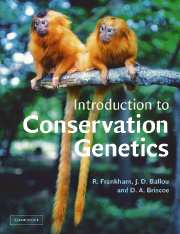Book contents
- Frontmatter
- Contents
- Preface
- Copyright acknowledgments
- Chapter 1 Introduction
- Chapter 2 Genetics and extinction
- SECTION I EVOLUTIONARY GENETICS OF NATURAL POPULATIONS
- SECTION II EFFECTS OF POPULATION SIZE REDUCTION
- SECTION III FROM THEORY TO PRACTICE
- Take home messages from this book
- Revision problems
- Glossary
- Answers to problems
- References
- Index
SECTION I - EVOLUTIONARY GENETICS OF NATURAL POPULATIONS
Published online by Cambridge University Press: 05 June 2012
- Frontmatter
- Contents
- Preface
- Copyright acknowledgments
- Chapter 1 Introduction
- Chapter 2 Genetics and extinction
- SECTION I EVOLUTIONARY GENETICS OF NATURAL POPULATIONS
- SECTION II EFFECTS OF POPULATION SIZE REDUCTION
- SECTION III FROM THEORY TO PRACTICE
- Take home messages from this book
- Revision problems
- Glossary
- Answers to problems
- References
- Index
Summary
Since our objective in conservation genetics is to preserve species as dynamic entities, capable of evolving to adapt with environmental change, it is essential to understand the natural forces determining evolutionary change. Such information is indispensable if we are to understand how to genetically manage threatened and endangered populations. Since evolution at its most basic level is a change in the genetic composition of a population, it only occurs when there is genetic diversity. Consequently, we need to appreciate how genetic diversity arises, how it is lost, and what forms of genetic diversity exist.
Extent of genetic diversity
Chapter 3 introduces methods for measuring genetic diversity for DNA, proteins, deleterious alleles and quantitative characters, and documents levels of genetic diversity for them. Most large populations of animals and plants contain extensive genetic diversity. However, levels of genetic diversity are often reduced in small populations, island populations and endangered species.
Genetic constitution of populations
To evaluate changes in genetic diversity, we must have means for quantifying it. Chapter 4 covers the estimation of allele (gene) frequencies and heterozygosity that are used to describe diversity at single loci. Chapter 5 describes the measures used to characterize genetic diversity for quantitative characters, especially the concept of heritability. Quantitative characters are centrally involved in the major areas of conservation concern, evolutionary potential, the deleterious effects of inbreeding and the deleterious effects that sometimes occur when different populations are mixed.
- Type
- Chapter
- Information
- Introduction to Conservation Genetics , pp. 43 - 44Publisher: Cambridge University PressPrint publication year: 2002



